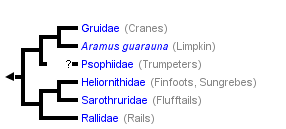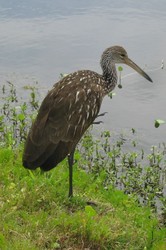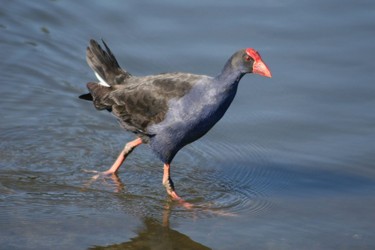Gruiformes
Cranes, Rails, Coots, and allies
John Harshman


This tree diagram shows the relationships between several groups of organisms.
The root of the current tree connects the organisms featured in this tree to their containing group and the rest of the Tree of Life. The basal branching point in the tree represents the ancestor of the other groups in the tree. This ancestor diversified over time into several descendent subgroups, which are represented as internal nodes and terminal taxa to the right.

You can click on the root to travel down the Tree of Life all the way to the root of all Life, and you can click on the names of descendent subgroups to travel up the Tree of Life all the way to individual species.
For more information on ToL tree formatting, please see Interpreting the Tree or Classification. To learn more about phylogenetic trees, please visit our Phylogenetic Biology pages.
close boxDiscussion of Phylogenetic Relationships
The traditional order Gruiformes is not a natural group, and scientists have been detaching families from it for some time, starting with Pedionomidae (plains wanderer) to Charadriiformes, then Turnicidae (buttonquail) also to Charadriiformes. Recently Cariamidae (seriemas), Otididae (bustards), Mesitornithidae (mesites), Rhynochetidae (kagu), and Eurypygidae (sunbittern) have also been remove from the order. Their true relationships are not clear except that the latter two form a clade.
What remains is the core of Gruiformes, the former suborder Grues, which show close affinities in both morphological (Cracraft, 1982; Livezey, 1998) and DNA (Sibley and Ahlquist, 1990; Houde et al., 1997; Fain et al., 2007, Hackett et al. 2008) comparisons. Relationships here are based on Hackett et al. (2008).
The traditional family Rallidae is paraphyletic, since one unusual rail genus, Sarothrura (flufftails, here elevated to family level) is more closely related to Heliornithidae (finfoots) than to typical rails.
References
Cracraft, J. 1982. Phylogenetic relationships and transatlantic biogeography of some gruiform birds. Geobios, Mem. Spec. 6: 393-402.
Fain, M. G., and P. Houde. 2004. Parallel radiations in the primary clades of birds. Evolution 58:2558-2573.
Fain, M. G., C. Krajewski, and P. Houde. 2007. Phylogeny of “core Gruiformes” (Aves: Grues) and resolution of the Limpkin–Sungrebe problem. Molecular Phylogenetics and Evolution 43 (2): 515-529.
Hackett, S. J., Kimball, R. T., Reddy, S., Bowie, R. C. K., Braun, E. L., Braun, M. J., Chojnowski, J. L., Cox, W. A., Han, K.-L., Harshman, J., Huddleston, C. J., Marks, B. D., Miglia, K. J., Moore, W. A., Sheldon, F. H., Steadman, D. W., Witt, C. C., and Yuri, T. 2008. A phylogenomic study of birds reveals their evolutionary history. Science 320(5884):1763-1768.
Houde, P., A. Cooper, E. Leslie, A. E. Strand, and G. A. Montano. 1997. Phylogeney and evolution of 12S rDNA in Gruiformes (Aves). In: Mindell, D. P. (ed.), Avian Molecular Evolution and Systematics. Academic Press, San Diego. Pp. 121-158.
Livezey, B. C. 1998 A phylogenetic analysis of the Gruiformes (Aves) based on morphological characters, with an emphasis on rails (Rallidae). Phil. Trans. Roy. Soc. Lond. 353: 2077-2151.
Livezey, B. C., and R. L. Zusi. 2007. Higher-order phylogeny of modern birds (Theropoda, Aves: Neornithes) based on comparative anatomy. II. Analysis and discussion. Zoological Journal of the Linnean Society 149 (1): 1-95.
Sibley, C. G. and Ahlquist, J. E. 1990. Phylogeny and classification of birds: a study in molecular evolution. Yale University Press, New Haven.
Taylor, B. 1998. Rails: A Guide to the Rails, Crakes, Gallinules and Coots of the World. New Haven, CT: Yale University Press.
Title Illustrations

| Scientific Name | Aramus guarauna |
|---|---|
| Location | Sarasota, Florida, USA |
| Specimen Condition | Live Specimen |
| Source | One leg is a good as a rest |
| Source Collection | Flickr |
| Image Use |
 This media file is licensed under the Creative Commons Attribution-NonCommercial-ShareAlike License - Version 2.0. This media file is licensed under the Creative Commons Attribution-NonCommercial-ShareAlike License - Version 2.0.
|
| Copyright | © 2005 Simon Bisson |
| Scientific Name | Porphyrio porphyrio |
|---|---|
| Location | Shortland Wetlands, Newcastle, New South Wales, Australia |
| Specimen Condition | Live Specimen |
| Source | Swamphen |
| Source Collection | Flickr |
| Image Use |
 This media file is licensed under the Creative Commons Attribution-NonCommercial License - Version 2.0. This media file is licensed under the Creative Commons Attribution-NonCommercial License - Version 2.0.
|
| Copyright | © 2006 Marj Kibby |
About This Page
Correspondence regarding this page should be directed to John Harshman at
Page copyright © 2008
 Page: Tree of Life
Gruiformes. Cranes, Rails, Coots, and allies.
Authored by
John Harshman.
The TEXT of this page is licensed under the
Creative Commons Attribution-NonCommercial License - Version 3.0. Note that images and other media
featured on this page are each governed by their own license, and they may or may not be available
for reuse. Click on an image or a media link to access the media data window, which provides the
relevant licensing information. For the general terms and conditions of ToL material reuse and
redistribution, please see the Tree of Life Copyright
Policies.
Page: Tree of Life
Gruiformes. Cranes, Rails, Coots, and allies.
Authored by
John Harshman.
The TEXT of this page is licensed under the
Creative Commons Attribution-NonCommercial License - Version 3.0. Note that images and other media
featured on this page are each governed by their own license, and they may or may not be available
for reuse. Click on an image or a media link to access the media data window, which provides the
relevant licensing information. For the general terms and conditions of ToL material reuse and
redistribution, please see the Tree of Life Copyright
Policies.
- First online 14 December 2005
- Content changed 27 June 2008
Citing this page:
Harshman, John. 2008. Gruiformes. Cranes, Rails, Coots, and allies. Version 27 June 2008 (under construction). http://tolweb.org/Gruiformes/26307/2008.06.27 in The Tree of Life Web Project, http://tolweb.org/












 Go to quick links
Go to quick search
Go to navigation for this section of the ToL site
Go to detailed links for the ToL site
Go to quick links
Go to quick search
Go to navigation for this section of the ToL site
Go to detailed links for the ToL site